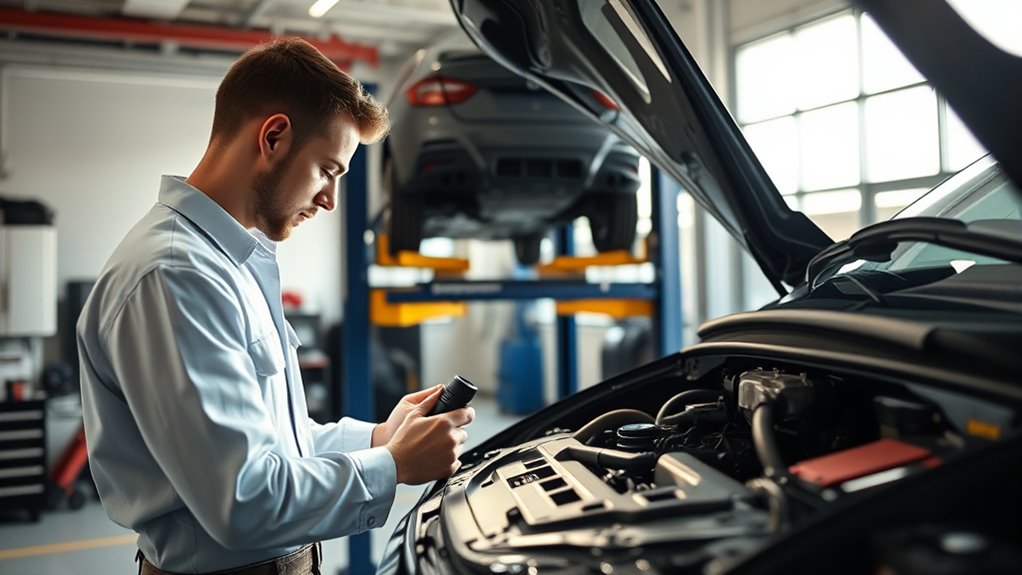During a multi-point inspection, your technician will thoroughly check various parts of your vehicle, including brakes, tires, fluids, battery, belts, hoses, suspension, and safety features. They’ll look for wear, damage, and proper levels to guarantee everything functions safely and efficiently. This process helps identify small issues before they become costly problems. Keep going, and you’ll discover how this detailed check keeps your vehicle in top shape and ready to go.
Key Takeaways
- The technician will perform a visual and physical inspection of critical components like brakes, tires, fluids, and belts.
- Expect to check brake pads, rotors, tire tread, and fluid levels for safety and performance.
- The process includes assessing suspension, battery health, lights, wipers, and other safety features.
- Any issues found may be explained, and recommendations for repairs or maintenance will be discussed.
- The inspection typically concludes with a summary of vehicle condition and suggested next steps.

Ever wondered how you can catch potential car problems before they become costly repairs? A multi-point inspection is your best bet. When you take your vehicle in for this thorough check, technicians systematically examine various components to guarantee everything runs smoothly. One of the first areas they focus on is your brake system. Brakes are essential for safety, so during the inspection, they’ll check the brake pads for wear, measure the brake fluid levels, and inspect the rotors and calipers for any signs of damage or warping. If your brakes are showing signs of deterioration, catching these early can prevent more serious issues like complete brake failure or costly repairs down the line.
Another key aspect of a multi-point inspection is evaluating your tire condition. Your tires are the only contact between your vehicle and the road, making their condition critical for safety and performance. The technician will examine the tread depth to ensure there’s enough grip, check for uneven wear patterns that could indicate alignment or suspension problems, and look for any cuts, punctures, or sidewall damage. They might also measure tire pressure to confirm it’s within the recommended range. Properly maintained tires improve your vehicle’s handling, fuel efficiency, and safety, so this step helps you identify issues before they lead to blowouts or dangerous driving conditions.
Beyond the brake system and tire condition, a multi-point inspection covers other essential areas. The technician will review your fluid levels—like engine oil, transmission fluid, coolant, and windshield washer fluid—and top them off if necessary. They also inspect your battery for corrosion and proper connection, check your belts and hoses for cracks or wear, and evaluate your suspension components for stability and comfort. During the process, they might also look at your lights, wipers, and other safety features to guarantee everything functions correctly. Regular inspections can also uncover hidden issues that could otherwise go unnoticed until they cause major problems.
This exhaustive check might seem routine, but it’s designed to catch small issues before they escalate. For you, it means peace of mind, better safety, and potentially avoiding expensive repairs down the road. Plus, many providers offer multi-point inspections at regular intervals or with other services, making it a convenient way to keep your car in top shape. So, next time you hear about a multi-point inspection, remember it’s your vehicle’s early warning system—helping you stay safe and save money by addressing problems early.
Frequently Asked Questions
How Long Does a Multi-Point Inspection Typically Take?
A multi-point inspection usually takes about 30 to 60 minutes, depending on your vehicle’s make and model. The inspection duration can vary based on how thorough the check is and any issues found along the way. You should plan for the appointment length accordingly, so you’re not rushed. It’s a good idea to schedule your appointment ahead of time to guarantee the process is smooth and efficient for you.
Is a Multi-Point Inspection Necessary for New Vehicles?
A multi-point inspection isn’t just for old vehicles; studies show 60% of new car issues can be caught early this way. You should consider it for your new vehicle because it enhances vehicle safety and keeps it running smoothly. Think of it as a maintenance checklist that guarantees every system, from brakes to lights, works properly. This proactive step helps prevent future problems and extends your car’s lifespan, giving you peace of mind.
What Are the Costs Associated With a Multi-Point Inspection?
Inspection costs typically range from $50 to $150, depending on your vehicle’s make, model, and the shop’s pricing factors. You might pay more if your car requires additional checks or specialized services. Some shops offer free multi-point inspections with other services or as part of a maintenance package. Always ask for a detailed estimate beforehand so you know what to expect and can compare pricing factors across providers.
Can I Request Specific Areas to Be Checked During the Inspection?
Yes, you can request customizable checks for specific areas during your inspection. Just let your technician know which parts or systems you want them to focus on. This way, you guarantee those areas are thoroughly examined, giving you peace of mind. Keep in mind, customizing checks might affect the overall time and cost, but it allows you to prioritize the maintenance or concerns that matter most to you.
How Often Should I Get a Multi-Point Inspection?
Think of a multi-point inspection as your vehicle’s weekly comic strip—something you want to keep current. You should get one every 6,000 to 12,000 miles or during routine maintenance visits. Regular inspections help guarantee vehicle safety and catch potential issues early. If you notice any strange sounds or warning lights, don’t wait—schedule an inspection sooner. Staying proactive keeps your car running smoothly and safely, just like a trusty sidekick.
Conclusion
Think of a multi-point inspection like a health check-up for your car. It catches small issues before they become big problems, keeping your vehicle running smoothly and safely. Just as regular visits to the doctor maintain your well-being, these inspections guarantee your car stays in top shape. So, embrace this routine as a crucial tune-up, giving you peace of mind on the road and avoiding unexpected breakdowns. Your car will thank you for it!









